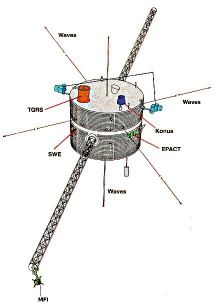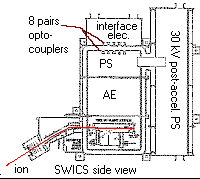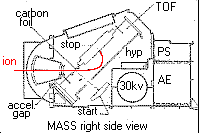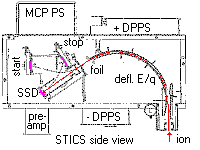

WIND/SMS
University of Maryland Space Physics GroupWelcome to the WIND/SMS homepage at the University of Maryland. This page will give you general information about the WIND mission and the three sensors which comprise the SWICS/MASS/STICS (SMS) package. You will also find sample data plots obtained from SMS and the names of some of the people involved. Please return often as we will continue to update and upgrade this site.
Contents:
- The WIND mission
- SMS scientific objectives
- The SWICS sensor
- The MASS sensor
- The STICS sensor
- SMS Data
- Bibliography - including upcoming talks! NEW
- The SMS team
- Related WWW sites


The WIND mission:
The WIND spacecraft was launched on November 1, 1994 by a Delta II rocket from Cape Canaveral Air Station. For the first two years of the mission WIND will be in a highly elliptical orbit on the sunward side of the Earth with an apogee of 250 Earth radii and a perigee of at least 5 Earth radii. Multiple double lunar swingbys allow WIND to maximize the amount of time it spends directly upstream of the earth monitoring the solar wind. Later WIND will be inserted into a halo orbit at the Earth-Sun L1 point.
The nine instruments onboard allow constant monitoring of the solar wind plasma, energetic particles, magnetic fields, radio and plasma waves found in the interplanetary medium as well as cosmic gamma ray bursts. For more information concerning the different instruments please visit the NASA WIND homepage. For the current status of the WIND spacecraft see NASA WIND status.
SMS scientific objectives:
Measurements from the Solar Wind Ion Composition Spectrometer (SWICS), the High MASS Resolution Spectrometer (MASS) and the SupraThermal Ion Composition Spectrometer (STICS) will allow the SMS package to study the following issues:
- solar abundances
- solar wind acceleration
- physical processes in the solar atmosphere
- physical properties of the lower corona
- solar wind kinetic properties
- production of suprathermal ions
- interplanetary acceleration mechanisms
- pick-up and acceleration processes of interstellar and lunar neutrals
For a detailed discussion of these objectives we refer you to The Solar Wind and Suprathermal Ion Composition Investigation on the Wind Spacecraft by Gloeckler, et al. Space Sci. Rev., 71, 79, 1995.

The SWICS sensor
SWICS is designed to measure the mass and charge composition of the solar wind ions from H to Fe over the energy/charge range of 0.5 to 30 keV/e. The instrument employs electrostatic deflection, time-of-flight measurement and a residual energy measurement to accomplish this. The electrostatic deflection is stepped through 60 logarithmically spaced steps typically at a rate of one step per spacecraft rotation (the spacecraft rotates at a rate of 20 rpm) thus selecting ions by their energy/charge (E/q). An ion passing through the deflection system is post accelerated by 23 kV (typically) before entering the time-of-flight chamber. Here the ion passes through a thin carbon foil scattering electrons which are collected by a microchannel plate (MCP), producing a start signal. The ion continues along the flight path, stopping in a solid state detector (SSD). Secondary electrons are emitted and collected by a second MCP, generating a stop pulse. The time-of-flight (TOF) is calculated from the start and stop signals. If the ion is energetic enough its residual energy (Emeas) will be measured by the SSD.
Using these three measured quantities, E/q, TOF and Emeas, an ion¹s mass and mass/charge can be determined from the following equations:
M/q = 2(TOF/d)^2 * (Va + a*E/q)
M = 2(TOF/d)^2 * Emeas/b
where d is the flight path length, Va is the post-acceleration voltage, a accounts for the energy loss in the carbon foil, and b accounts for the pulse-height defect in the SSD.
A particle is uniquely identified by its mass and mass/charge. Thus ions unresolved by standard electrostatic deflection instruments can be separated, e.g., O8+, C6+, and He2+.
The MASS sensor 
MASS is designed to measure the elemental and isotopic composition of the solar wind from 0.5 to 12 keV/e. MASS combines an electrostatic deflection system with a static electric harmonic potential inside the time-of- flight analyzer to obtain mass resolutions of M/M ~ 100. As ion passes through a thin carbon foil to enter the time-of-flight system secondary electrons are scattered and collected by a microchannel plate (MCP) to generate a start signal. The harmonic potential causes the ion to travel in a parabolic trajectory, impinging on a second MCP to create the stop signal. The potential also causes the time-of-flight (calculated from the start and stop pulses) to be only a function of the mass/charge* of the particle, where the charge is that of the ion after passing through the carbon foil. Since most of the particles emerge either neutral or singly charged the calculated time-of- flight is proportional to mass (a time-of-flight is not determined for the neutral particles).
Since the resolution of the time-of-flight analyzer is high and the time- of-flight is independent of energy, isotopes of elements heavier than He can be easily resolved.
The STICS sensor 
STICS is designed to measure the mass and mass/charge of suprathermal ions. It is similar to SWICS in that it employs electrostatic deflection, time-of-flight and residual energy measurements. The electrostatic deflection system covers a range of 6 to 223 keV/e in 30 logarithmic steps (1 step per rotation of the spacecraft). An ion experiences no post acceleration prior to entering the time-of-flight chamber. The ion¹s time- of-flight (TOF) is calculated from start and stop pulses created by the collection of scattered electrons by microchannel plates at the beginning and end of the ion¹s flight path. These scattered electrons are generated when the ion passes through a thin carbon foil at the entrance of the chamber and when it impinges on the solid state detector at the end. The solid state detector also measures the residual energy (Emeas) of the ion.
Using these three measured quantities, E/q, TOF and Emeas, an ion is uniquely identified by its mass and mass/charge determined from the following equations:
M = 2(TOF/d)^2 * Emeas/b
where d is the flight path length, a accounts for the energy loss in the carbon foil, and b accounts for the pulse-height defect in the SSD.
The SMS team:
University of Maryland - (301) 405-6199 (main number) / (301) 314-9547 (fax)
- George Gloeckler - PI
- Fred Ipavich - SWICS Co-I
- Doug Hamilton - MASS Co-I
- Toni Galvin - STICS Co-I
- Sham Chotoo
- Christina Cohen
- Michael Collier
- George Ho
- John Paquette
University of Bern
- Peter Bochsler
- Hans Balsiger
- Johannes Geiss
- Olivier Kern
Max-Planck-Institut für Extraterrestrische Physik
- Dietrich Hovestadt
- Alfred Bürgi
Max-Planck-Institut für Aeronomie
- Erhard Kirsch
- Berend Wilken
Technische Universität Braunschweig
- Fritz Gleim
High Altitude Observatory (NCAR)
- Tom Holzer
Goddard Space Flight Center
- Keith Ogilvie
Related WWW sites:
Wind/SMS at the University of BernGGS Mission Operations Home Page
ISTP Wind homepage
Spacecraft status reports
Wind Key Parameter data at CDAW
If you have any comments/suggestions regarding this homepage please email Kuen Ko at ko@umdsp.umd.edu
updated 1/24/97 - added link to Steve Hearn's GGS Mission Operations Home Page